Destination Marketing Report: Analysis of Nicaragua's Tourism Sector
VerifiedAdded on 2019/12/04
|12
|4114
|29
Report
AI Summary
This report delves into the destination marketing strategies for Nicaragua, focusing on the country's tourism potential and the implementation of effective marketing campaigns. It begins with an introduction to destination marketing and its significance, particularly in the context of Nicaragua, highlighting its natural attractions like volcanoes and eco-tourism destinations. The report identifies the target market, primarily adventure tourists, backpackers, and eco-tourism enthusiasts, with a focus on the 25-48 age group. It then discusses the selected marketing strategy, emphasizing the use of segmentation, targeting, and positioning. A detailed marketing mix is presented, covering product (eco-tourism and adventure packages), price (affordable tour packages), place (Cerro Negro for volcano boarding), and promotion (advertisements in travel magazines and social media). The report also considers additional elements like physical evidence, people, and process. Finally, it outlines SMART objectives for increasing tourism, including specific goals for growth, peak season promotion, online bookings, and website traffic, thereby providing a comprehensive marketing plan for Nicaragua's tourism sector.
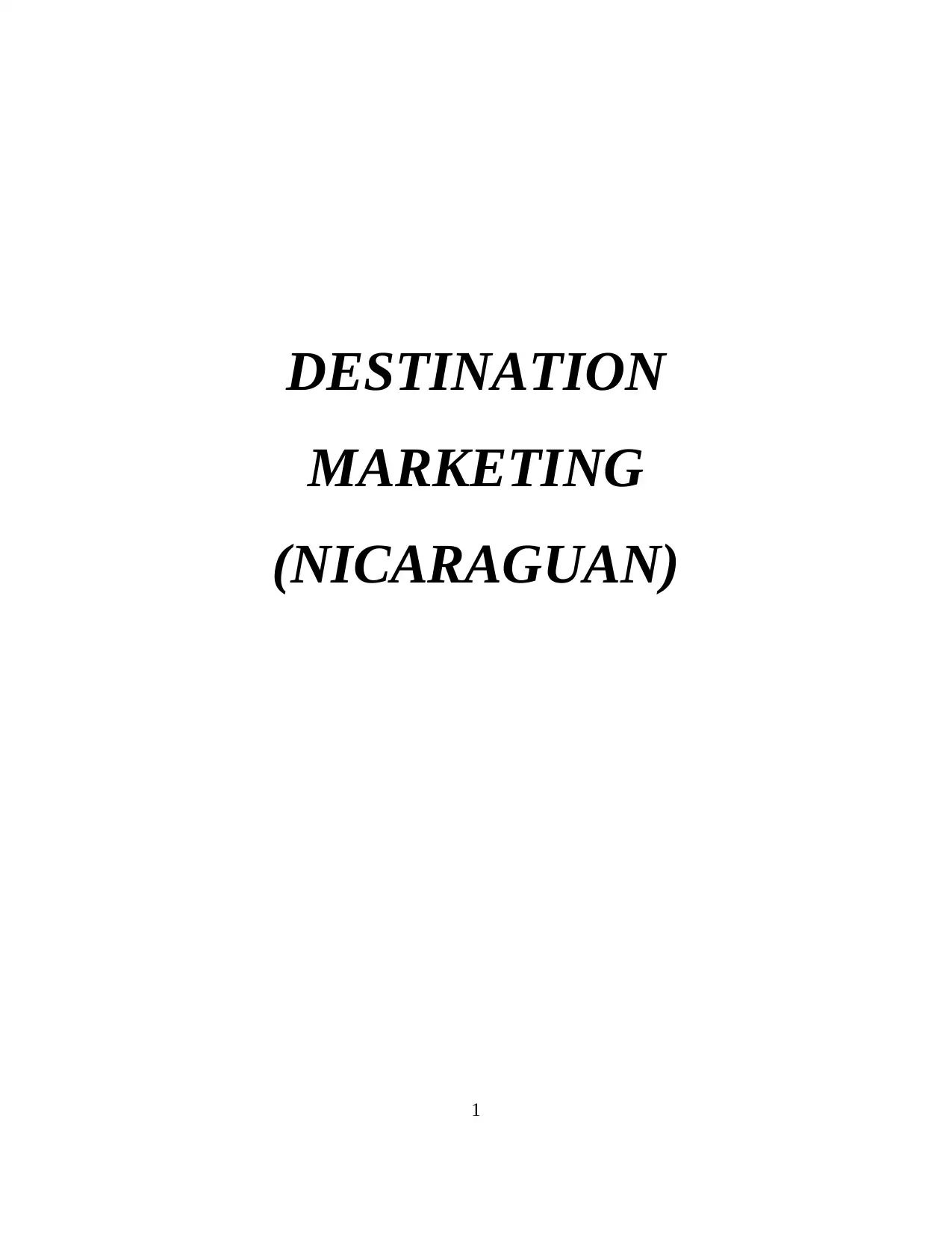
DESTINATION
MARKETING
(NICARAGUAN)
1
MARKETING
(NICARAGUAN)
1
Paraphrase This Document
Need a fresh take? Get an instant paraphrase of this document with our AI Paraphraser
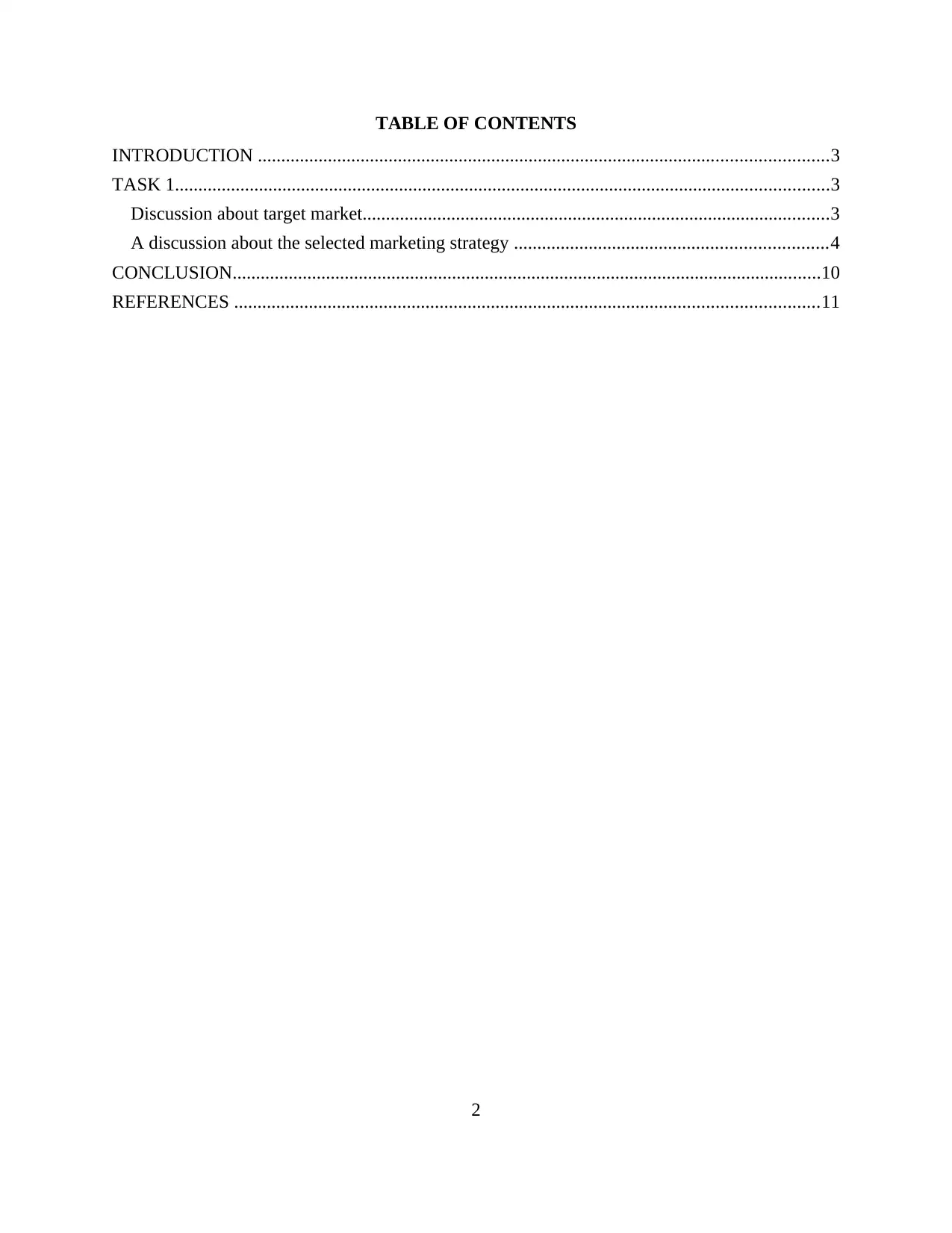
TABLE OF CONTENTS
INTRODUCTION ..........................................................................................................................3
TASK 1............................................................................................................................................3
Discussion about target market....................................................................................................3
A discussion about the selected marketing strategy ...................................................................4
CONCLUSION..............................................................................................................................10
REFERENCES .............................................................................................................................11
2
INTRODUCTION ..........................................................................................................................3
TASK 1............................................................................................................................................3
Discussion about target market....................................................................................................3
A discussion about the selected marketing strategy ...................................................................4
CONCLUSION..............................................................................................................................10
REFERENCES .............................................................................................................................11
2
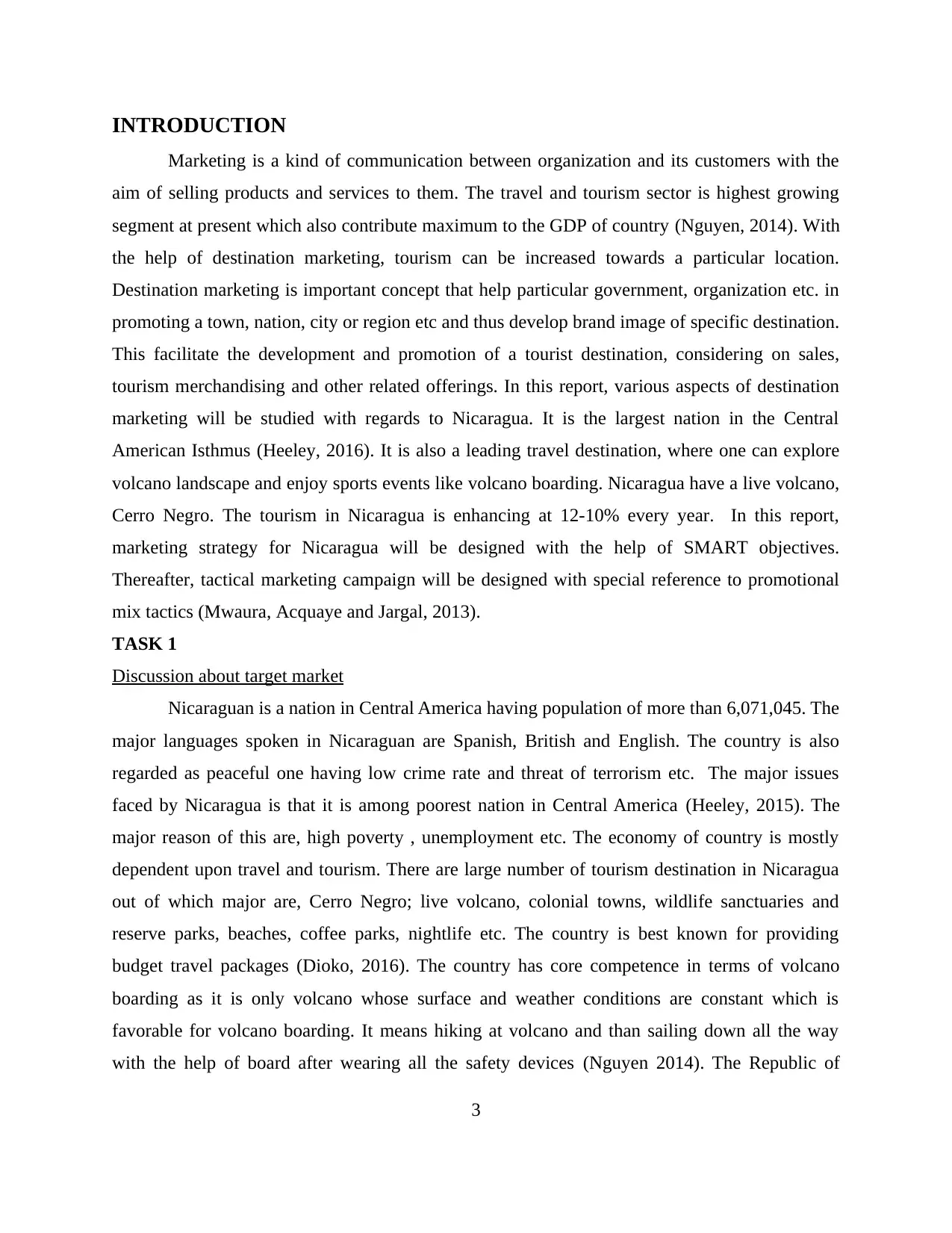
INTRODUCTION
Marketing is a kind of communication between organization and its customers with the
aim of selling products and services to them. The travel and tourism sector is highest growing
segment at present which also contribute maximum to the GDP of country (Nguyen, 2014). With
the help of destination marketing, tourism can be increased towards a particular location.
Destination marketing is important concept that help particular government, organization etc. in
promoting a town, nation, city or region etc and thus develop brand image of specific destination.
This facilitate the development and promotion of a tourist destination, considering on sales,
tourism merchandising and other related offerings. In this report, various aspects of destination
marketing will be studied with regards to Nicaragua. It is the largest nation in the Central
American Isthmus (Heeley, 2016). It is also a leading travel destination, where one can explore
volcano landscape and enjoy sports events like volcano boarding. Nicaragua have a live volcano,
Cerro Negro. The tourism in Nicaragua is enhancing at 12-10% every year. In this report,
marketing strategy for Nicaragua will be designed with the help of SMART objectives.
Thereafter, tactical marketing campaign will be designed with special reference to promotional
mix tactics (Mwaura, Acquaye and Jargal, 2013).
TASK 1
Discussion about target market
Nicaraguan is a nation in Central America having population of more than 6,071,045. The
major languages spoken in Nicaraguan are Spanish, British and English. The country is also
regarded as peaceful one having low crime rate and threat of terrorism etc. The major issues
faced by Nicaragua is that it is among poorest nation in Central America (Heeley, 2015). The
major reason of this are, high poverty , unemployment etc. The economy of country is mostly
dependent upon travel and tourism. There are large number of tourism destination in Nicaragua
out of which major are, Cerro Negro; live volcano, colonial towns, wildlife sanctuaries and
reserve parks, beaches, coffee parks, nightlife etc. The country is best known for providing
budget travel packages (Dioko, 2016). The country has core competence in terms of volcano
boarding as it is only volcano whose surface and weather conditions are constant which is
favorable for volcano boarding. It means hiking at volcano and than sailing down all the way
with the help of board after wearing all the safety devices (Nguyen 2014). The Republic of
3
Marketing is a kind of communication between organization and its customers with the
aim of selling products and services to them. The travel and tourism sector is highest growing
segment at present which also contribute maximum to the GDP of country (Nguyen, 2014). With
the help of destination marketing, tourism can be increased towards a particular location.
Destination marketing is important concept that help particular government, organization etc. in
promoting a town, nation, city or region etc and thus develop brand image of specific destination.
This facilitate the development and promotion of a tourist destination, considering on sales,
tourism merchandising and other related offerings. In this report, various aspects of destination
marketing will be studied with regards to Nicaragua. It is the largest nation in the Central
American Isthmus (Heeley, 2016). It is also a leading travel destination, where one can explore
volcano landscape and enjoy sports events like volcano boarding. Nicaragua have a live volcano,
Cerro Negro. The tourism in Nicaragua is enhancing at 12-10% every year. In this report,
marketing strategy for Nicaragua will be designed with the help of SMART objectives.
Thereafter, tactical marketing campaign will be designed with special reference to promotional
mix tactics (Mwaura, Acquaye and Jargal, 2013).
TASK 1
Discussion about target market
Nicaraguan is a nation in Central America having population of more than 6,071,045. The
major languages spoken in Nicaraguan are Spanish, British and English. The country is also
regarded as peaceful one having low crime rate and threat of terrorism etc. The major issues
faced by Nicaragua is that it is among poorest nation in Central America (Heeley, 2015). The
major reason of this are, high poverty , unemployment etc. The economy of country is mostly
dependent upon travel and tourism. There are large number of tourism destination in Nicaragua
out of which major are, Cerro Negro; live volcano, colonial towns, wildlife sanctuaries and
reserve parks, beaches, coffee parks, nightlife etc. The country is best known for providing
budget travel packages (Dioko, 2016). The country has core competence in terms of volcano
boarding as it is only volcano whose surface and weather conditions are constant which is
favorable for volcano boarding. It means hiking at volcano and than sailing down all the way
with the help of board after wearing all the safety devices (Nguyen 2014). The Republic of
3
⊘ This is a preview!⊘
Do you want full access?
Subscribe today to unlock all pages.

Trusted by 1+ million students worldwide
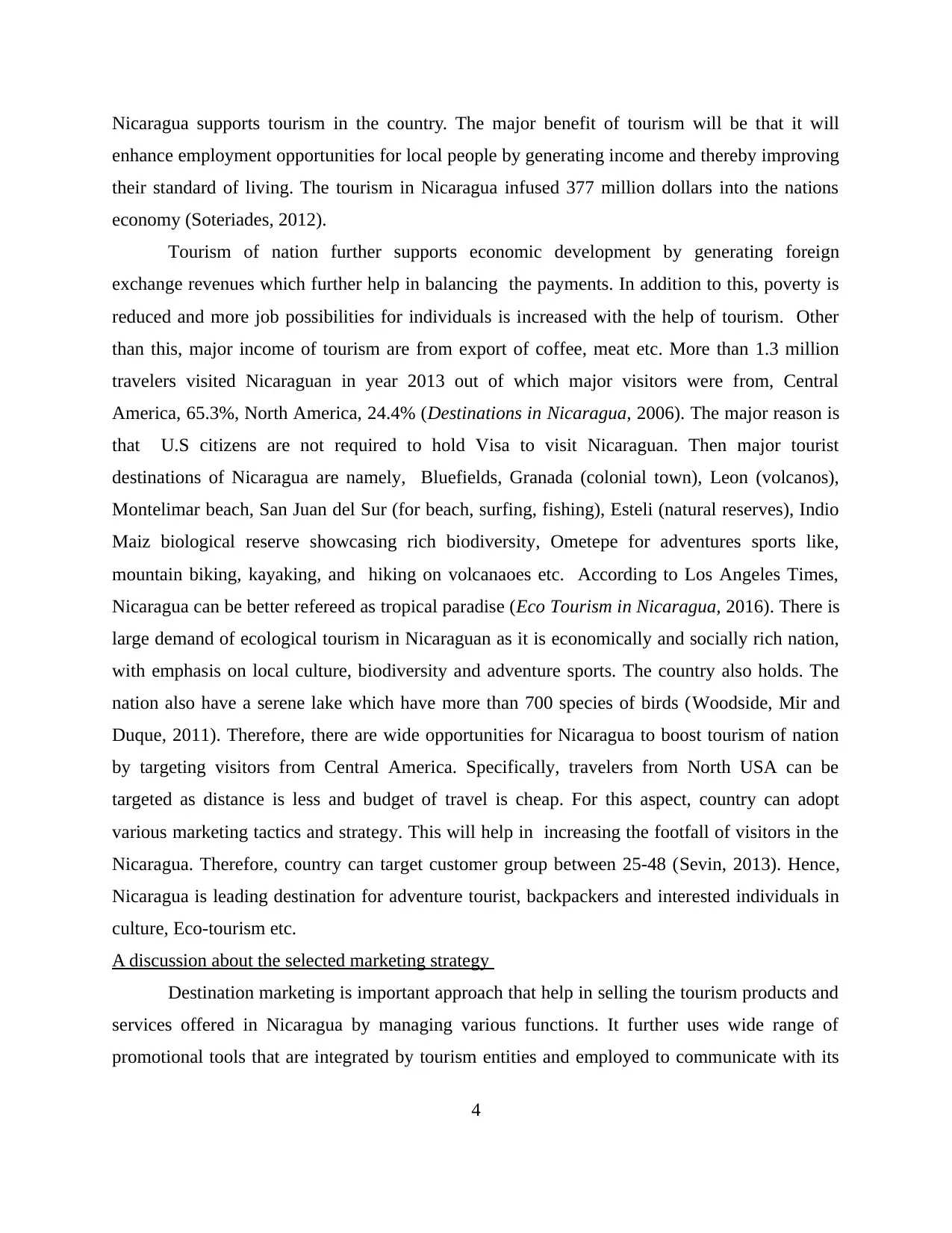
Nicaragua supports tourism in the country. The major benefit of tourism will be that it will
enhance employment opportunities for local people by generating income and thereby improving
their standard of living. The tourism in Nicaragua infused 377 million dollars into the nations
economy (Soteriades, 2012).
Tourism of nation further supports economic development by generating foreign
exchange revenues which further help in balancing the payments. In addition to this, poverty is
reduced and more job possibilities for individuals is increased with the help of tourism. Other
than this, major income of tourism are from export of coffee, meat etc. More than 1.3 million
travelers visited Nicaraguan in year 2013 out of which major visitors were from, Central
America, 65.3%, North America, 24.4% (Destinations in Nicaragua, 2006). The major reason is
that U.S citizens are not required to hold Visa to visit Nicaraguan. Then major tourist
destinations of Nicaragua are namely, Bluefields, Granada (colonial town), Leon (volcanos),
Montelimar beach, San Juan del Sur (for beach, surfing, fishing), Esteli (natural reserves), Indio
Maiz biological reserve showcasing rich biodiversity, Ometepe for adventures sports like,
mountain biking, kayaking, and hiking on volcanaoes etc. According to Los Angeles Times,
Nicaragua can be better refereed as tropical paradise (Eco Tourism in Nicaragua, 2016). There is
large demand of ecological tourism in Nicaraguan as it is economically and socially rich nation,
with emphasis on local culture, biodiversity and adventure sports. The country also holds. The
nation also have a serene lake which have more than 700 species of birds (Woodside, Mir and
Duque, 2011). Therefore, there are wide opportunities for Nicaragua to boost tourism of nation
by targeting visitors from Central America. Specifically, travelers from North USA can be
targeted as distance is less and budget of travel is cheap. For this aspect, country can adopt
various marketing tactics and strategy. This will help in increasing the footfall of visitors in the
Nicaragua. Therefore, country can target customer group between 25-48 (Sevin, 2013). Hence,
Nicaragua is leading destination for adventure tourist, backpackers and interested individuals in
culture, Eco-tourism etc.
A discussion about the selected marketing strategy
Destination marketing is important approach that help in selling the tourism products and
services offered in Nicaragua by managing various functions. It further uses wide range of
promotional tools that are integrated by tourism entities and employed to communicate with its
4
enhance employment opportunities for local people by generating income and thereby improving
their standard of living. The tourism in Nicaragua infused 377 million dollars into the nations
economy (Soteriades, 2012).
Tourism of nation further supports economic development by generating foreign
exchange revenues which further help in balancing the payments. In addition to this, poverty is
reduced and more job possibilities for individuals is increased with the help of tourism. Other
than this, major income of tourism are from export of coffee, meat etc. More than 1.3 million
travelers visited Nicaraguan in year 2013 out of which major visitors were from, Central
America, 65.3%, North America, 24.4% (Destinations in Nicaragua, 2006). The major reason is
that U.S citizens are not required to hold Visa to visit Nicaraguan. Then major tourist
destinations of Nicaragua are namely, Bluefields, Granada (colonial town), Leon (volcanos),
Montelimar beach, San Juan del Sur (for beach, surfing, fishing), Esteli (natural reserves), Indio
Maiz biological reserve showcasing rich biodiversity, Ometepe for adventures sports like,
mountain biking, kayaking, and hiking on volcanaoes etc. According to Los Angeles Times,
Nicaragua can be better refereed as tropical paradise (Eco Tourism in Nicaragua, 2016). There is
large demand of ecological tourism in Nicaraguan as it is economically and socially rich nation,
with emphasis on local culture, biodiversity and adventure sports. The country also holds. The
nation also have a serene lake which have more than 700 species of birds (Woodside, Mir and
Duque, 2011). Therefore, there are wide opportunities for Nicaragua to boost tourism of nation
by targeting visitors from Central America. Specifically, travelers from North USA can be
targeted as distance is less and budget of travel is cheap. For this aspect, country can adopt
various marketing tactics and strategy. This will help in increasing the footfall of visitors in the
Nicaragua. Therefore, country can target customer group between 25-48 (Sevin, 2013). Hence,
Nicaragua is leading destination for adventure tourist, backpackers and interested individuals in
culture, Eco-tourism etc.
A discussion about the selected marketing strategy
Destination marketing is important approach that help in selling the tourism products and
services offered in Nicaragua by managing various functions. It further uses wide range of
promotional tools that are integrated by tourism entities and employed to communicate with its
4
Paraphrase This Document
Need a fresh take? Get an instant paraphrase of this document with our AI Paraphraser
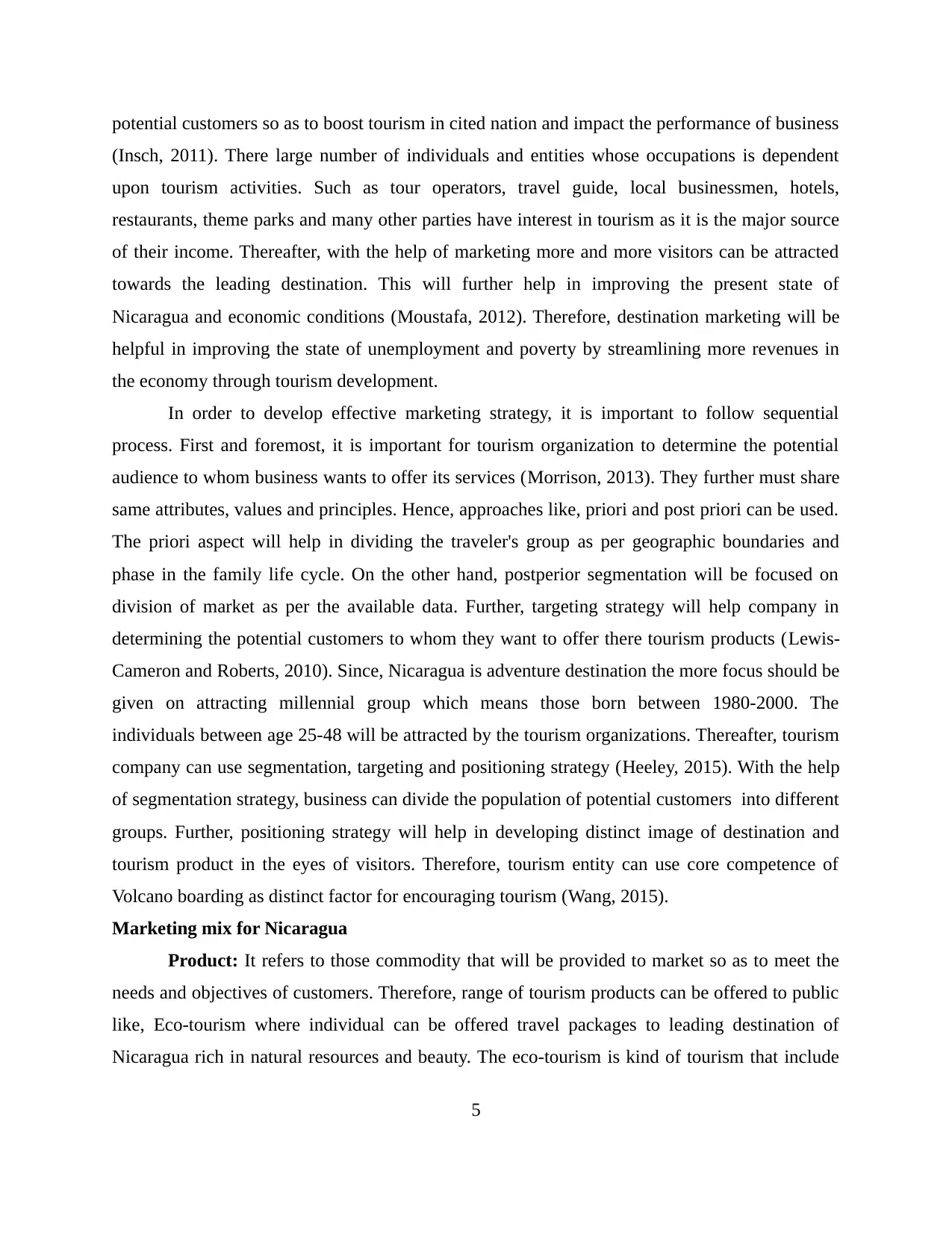
potential customers so as to boost tourism in cited nation and impact the performance of business
(Insch, 2011). There large number of individuals and entities whose occupations is dependent
upon tourism activities. Such as tour operators, travel guide, local businessmen, hotels,
restaurants, theme parks and many other parties have interest in tourism as it is the major source
of their income. Thereafter, with the help of marketing more and more visitors can be attracted
towards the leading destination. This will further help in improving the present state of
Nicaragua and economic conditions (Moustafa, 2012). Therefore, destination marketing will be
helpful in improving the state of unemployment and poverty by streamlining more revenues in
the economy through tourism development.
In order to develop effective marketing strategy, it is important to follow sequential
process. First and foremost, it is important for tourism organization to determine the potential
audience to whom business wants to offer its services (Morrison, 2013). They further must share
same attributes, values and principles. Hence, approaches like, priori and post priori can be used.
The priori aspect will help in dividing the traveler's group as per geographic boundaries and
phase in the family life cycle. On the other hand, postperior segmentation will be focused on
division of market as per the available data. Further, targeting strategy will help company in
determining the potential customers to whom they want to offer there tourism products (Lewis-
Cameron and Roberts, 2010). Since, Nicaragua is adventure destination the more focus should be
given on attracting millennial group which means those born between 1980-2000. The
individuals between age 25-48 will be attracted by the tourism organizations. Thereafter, tourism
company can use segmentation, targeting and positioning strategy (Heeley, 2015). With the help
of segmentation strategy, business can divide the population of potential customers into different
groups. Further, positioning strategy will help in developing distinct image of destination and
tourism product in the eyes of visitors. Therefore, tourism entity can use core competence of
Volcano boarding as distinct factor for encouraging tourism (Wang, 2015).
Marketing mix for Nicaragua
Product: It refers to those commodity that will be provided to market so as to meet the
needs and objectives of customers. Therefore, range of tourism products can be offered to public
like, Eco-tourism where individual can be offered travel packages to leading destination of
Nicaragua rich in natural resources and beauty. The eco-tourism is kind of tourism that include
5
(Insch, 2011). There large number of individuals and entities whose occupations is dependent
upon tourism activities. Such as tour operators, travel guide, local businessmen, hotels,
restaurants, theme parks and many other parties have interest in tourism as it is the major source
of their income. Thereafter, with the help of marketing more and more visitors can be attracted
towards the leading destination. This will further help in improving the present state of
Nicaragua and economic conditions (Moustafa, 2012). Therefore, destination marketing will be
helpful in improving the state of unemployment and poverty by streamlining more revenues in
the economy through tourism development.
In order to develop effective marketing strategy, it is important to follow sequential
process. First and foremost, it is important for tourism organization to determine the potential
audience to whom business wants to offer its services (Morrison, 2013). They further must share
same attributes, values and principles. Hence, approaches like, priori and post priori can be used.
The priori aspect will help in dividing the traveler's group as per geographic boundaries and
phase in the family life cycle. On the other hand, postperior segmentation will be focused on
division of market as per the available data. Further, targeting strategy will help company in
determining the potential customers to whom they want to offer there tourism products (Lewis-
Cameron and Roberts, 2010). Since, Nicaragua is adventure destination the more focus should be
given on attracting millennial group which means those born between 1980-2000. The
individuals between age 25-48 will be attracted by the tourism organizations. Thereafter, tourism
company can use segmentation, targeting and positioning strategy (Heeley, 2015). With the help
of segmentation strategy, business can divide the population of potential customers into different
groups. Further, positioning strategy will help in developing distinct image of destination and
tourism product in the eyes of visitors. Therefore, tourism entity can use core competence of
Volcano boarding as distinct factor for encouraging tourism (Wang, 2015).
Marketing mix for Nicaragua
Product: It refers to those commodity that will be provided to market so as to meet the
needs and objectives of customers. Therefore, range of tourism products can be offered to public
like, Eco-tourism where individual can be offered travel packages to leading destination of
Nicaragua rich in natural resources and beauty. The eco-tourism is kind of tourism that include
5

visit to undisturbed natural areas (Kozak and Baloglu, 2012). Therefore, travel packages to top
Eco-tourism destination like, Granda, Parque nacional volcan masaya, lake Nicaragua, Zapatera,
Blue fields etc will be provided. In addition to this, adventure tourism can be provided which
will be specifically for bag packers, therefore, destination like, Cerro Negro which have active
volcano can be explored which also provides volcano boarding tours (Sevin, 2013). Thereafter,
tours to Ometepe can be offered which is island situated between two volcanoes, Concepcion and
Maderas. This destination also provide wide variety of sports.
Price: The prices of such tour packages should be kept affordable so as to increase the
attractiveness of these destinations (Insch, 2011). Therefore, qualitative tour packages at budget
prices can be offered to customers. Therefore, tour organization can chose various pricing
strategy like, cost plus strategy which enable business to recover the cost and than adding a
percentage margin so as to arrive at the final price of the product (Moustafa, 2012).
Place: It refers to location that would be central focus of the tourism organization. Since,
Nicaragua have core competence in terms of volcano boarding therefore, more consideration will
be given on attracting tourism to Cerro Negro (Heeley, 2015). The volcano is erupted just about
23 times in between 1850-1999. It is prime location for volcano boarding where visitors can
enjoy the adventure sports by wearing protective gear, googles etc. However, place consist of
various risk to travelers like, one can fall off, get physically hurt, danger of another eruption,
breathtaking toxicant gases, or being hurt by flaring molten lava (Kozak and Baloglu, 2012).
Promotion: It is important factor that help in increasing the knowledge of wide range of
audience regarding brand, so as to enhance the sales and develop brand reputation (Heeley,
2015). Therefore, concept of destination brand can be used which means using name, sign,
symbol etc. that can be used to differentiate the services offered in Nicaraguan which that of
other competitive destination like Costa Rica, Honduras, Guatemala etc. For promotion of these
destination, advertisement can be done in travel magazines, websites can be developed (Dioko,
2016). Further, social media marketing can be used where the volcano boarding concept and
other destination of Nicaragua can be promoted. In addition to this, concept of visual tour can be
used. With the help of promotion, tourism entities can develop induced image of destination so
as to stimulate maximum buyers to purchase the tour packages to Nicaragua (Nguyen, 2014).
6
Eco-tourism destination like, Granda, Parque nacional volcan masaya, lake Nicaragua, Zapatera,
Blue fields etc will be provided. In addition to this, adventure tourism can be provided which
will be specifically for bag packers, therefore, destination like, Cerro Negro which have active
volcano can be explored which also provides volcano boarding tours (Sevin, 2013). Thereafter,
tours to Ometepe can be offered which is island situated between two volcanoes, Concepcion and
Maderas. This destination also provide wide variety of sports.
Price: The prices of such tour packages should be kept affordable so as to increase the
attractiveness of these destinations (Insch, 2011). Therefore, qualitative tour packages at budget
prices can be offered to customers. Therefore, tour organization can chose various pricing
strategy like, cost plus strategy which enable business to recover the cost and than adding a
percentage margin so as to arrive at the final price of the product (Moustafa, 2012).
Place: It refers to location that would be central focus of the tourism organization. Since,
Nicaragua have core competence in terms of volcano boarding therefore, more consideration will
be given on attracting tourism to Cerro Negro (Heeley, 2015). The volcano is erupted just about
23 times in between 1850-1999. It is prime location for volcano boarding where visitors can
enjoy the adventure sports by wearing protective gear, googles etc. However, place consist of
various risk to travelers like, one can fall off, get physically hurt, danger of another eruption,
breathtaking toxicant gases, or being hurt by flaring molten lava (Kozak and Baloglu, 2012).
Promotion: It is important factor that help in increasing the knowledge of wide range of
audience regarding brand, so as to enhance the sales and develop brand reputation (Heeley,
2015). Therefore, concept of destination brand can be used which means using name, sign,
symbol etc. that can be used to differentiate the services offered in Nicaraguan which that of
other competitive destination like Costa Rica, Honduras, Guatemala etc. For promotion of these
destination, advertisement can be done in travel magazines, websites can be developed (Dioko,
2016). Further, social media marketing can be used where the volcano boarding concept and
other destination of Nicaragua can be promoted. In addition to this, concept of visual tour can be
used. With the help of promotion, tourism entities can develop induced image of destination so
as to stimulate maximum buyers to purchase the tour packages to Nicaragua (Nguyen, 2014).
6
⊘ This is a preview!⊘
Do you want full access?
Subscribe today to unlock all pages.

Trusted by 1+ million students worldwide
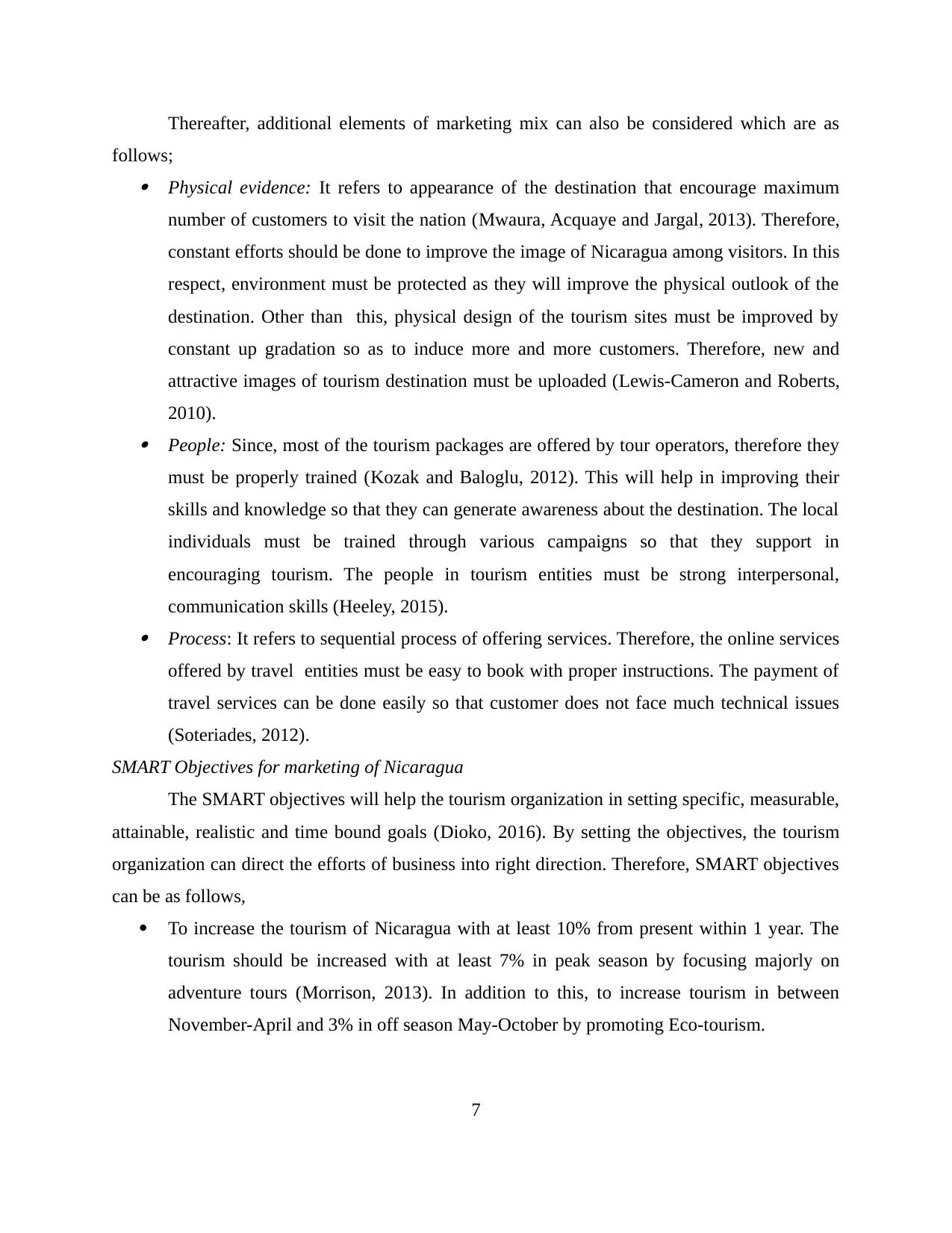
Thereafter, additional elements of marketing mix can also be considered which are as
follows; Physical evidence: It refers to appearance of the destination that encourage maximum
number of customers to visit the nation (Mwaura, Acquaye and Jargal, 2013). Therefore,
constant efforts should be done to improve the image of Nicaragua among visitors. In this
respect, environment must be protected as they will improve the physical outlook of the
destination. Other than this, physical design of the tourism sites must be improved by
constant up gradation so as to induce more and more customers. Therefore, new and
attractive images of tourism destination must be uploaded (Lewis-Cameron and Roberts,
2010). People: Since, most of the tourism packages are offered by tour operators, therefore they
must be properly trained (Kozak and Baloglu, 2012). This will help in improving their
skills and knowledge so that they can generate awareness about the destination. The local
individuals must be trained through various campaigns so that they support in
encouraging tourism. The people in tourism entities must be strong interpersonal,
communication skills (Heeley, 2015). Process: It refers to sequential process of offering services. Therefore, the online services
offered by travel entities must be easy to book with proper instructions. The payment of
travel services can be done easily so that customer does not face much technical issues
(Soteriades, 2012).
SMART Objectives for marketing of Nicaragua
The SMART objectives will help the tourism organization in setting specific, measurable,
attainable, realistic and time bound goals (Dioko, 2016). By setting the objectives, the tourism
organization can direct the efforts of business into right direction. Therefore, SMART objectives
can be as follows,
To increase the tourism of Nicaragua with at least 10% from present within 1 year. The
tourism should be increased with at least 7% in peak season by focusing majorly on
adventure tours (Morrison, 2013). In addition to this, to increase tourism in between
November-April and 3% in off season May-October by promoting Eco-tourism.
7
follows; Physical evidence: It refers to appearance of the destination that encourage maximum
number of customers to visit the nation (Mwaura, Acquaye and Jargal, 2013). Therefore,
constant efforts should be done to improve the image of Nicaragua among visitors. In this
respect, environment must be protected as they will improve the physical outlook of the
destination. Other than this, physical design of the tourism sites must be improved by
constant up gradation so as to induce more and more customers. Therefore, new and
attractive images of tourism destination must be uploaded (Lewis-Cameron and Roberts,
2010). People: Since, most of the tourism packages are offered by tour operators, therefore they
must be properly trained (Kozak and Baloglu, 2012). This will help in improving their
skills and knowledge so that they can generate awareness about the destination. The local
individuals must be trained through various campaigns so that they support in
encouraging tourism. The people in tourism entities must be strong interpersonal,
communication skills (Heeley, 2015). Process: It refers to sequential process of offering services. Therefore, the online services
offered by travel entities must be easy to book with proper instructions. The payment of
travel services can be done easily so that customer does not face much technical issues
(Soteriades, 2012).
SMART Objectives for marketing of Nicaragua
The SMART objectives will help the tourism organization in setting specific, measurable,
attainable, realistic and time bound goals (Dioko, 2016). By setting the objectives, the tourism
organization can direct the efforts of business into right direction. Therefore, SMART objectives
can be as follows,
To increase the tourism of Nicaragua with at least 10% from present within 1 year. The
tourism should be increased with at least 7% in peak season by focusing majorly on
adventure tours (Morrison, 2013). In addition to this, to increase tourism in between
November-April and 3% in off season May-October by promoting Eco-tourism.
7
Paraphrase This Document
Need a fresh take? Get an instant paraphrase of this document with our AI Paraphraser

To enhance the online booking to travel destination through promoting its official
website. Therefore, online booking must be increased with 8% in 6 months.
To increase the footfalls on the official website by 5% in 3 months.
To improve the tourism from the places of Central America with 10% in 1 year.
To sell at least 5 adventure travel packages each day.
To increase the marketing and promotion of Nicaragua by posting at least 2 videos of
various destination on Facebook, twitter and YouTube every day.
Further, the progress towards attainment of these objectives can be evaluated with the
help of various measures (Sevin, 2013). Therefore, search engine optimization can be used to
determine the number of individuals having knowledge of tourism and related services offered
through official website. Thereafter, change in sales of number of online tour packages can be
evaluated. The statistics can be obtained from airports so as to get data of number of international
visitors. Therefore, success at every level can be evaluated with the help of various soft and hard
indicators (Kozak and Baloglu, 2012). The hard one will take into account factors like, number
of tourist visit specifically to Cerro Negro while soft indicators calculate factors like,
improvement in awareness among public regarding tourism products offered in Nicaragua.
POSITIONING STRATEGY
The positioning strategy will help in developing different image of destination as
compared to its rivals (Sevin, 2013). There are various positioning strategy that can be used by
tourism organizations in Nicaragua. The description of which is as follows,
Cost leadership: It is important strategy that enable enterprises to keep lowest possible
cost in tourism industry (Wang, 2015). This strategy will help tourism organization of
Nicaragua to earn profits more than its competitors. Therefore, market share can be
easily enhanced using this strategy. The country is already known for providing budget
travel packages to large number of visitors (Kozak and Baloglu, 2012). Differentiation leadership: This strategy enable tourism entities in developing different
image of Nicaraguan by highlighting the distinct features of the country. This strategy
will help company in improving the revenue from tourism as unique features can be
highlighted and used as tool for increasing tourism (Mwaura, Acquaye and Jargal, 2013).
Hence,volcano boarding can be used as distinct factors that is core competence of
8
website. Therefore, online booking must be increased with 8% in 6 months.
To increase the footfalls on the official website by 5% in 3 months.
To improve the tourism from the places of Central America with 10% in 1 year.
To sell at least 5 adventure travel packages each day.
To increase the marketing and promotion of Nicaragua by posting at least 2 videos of
various destination on Facebook, twitter and YouTube every day.
Further, the progress towards attainment of these objectives can be evaluated with the
help of various measures (Sevin, 2013). Therefore, search engine optimization can be used to
determine the number of individuals having knowledge of tourism and related services offered
through official website. Thereafter, change in sales of number of online tour packages can be
evaluated. The statistics can be obtained from airports so as to get data of number of international
visitors. Therefore, success at every level can be evaluated with the help of various soft and hard
indicators (Kozak and Baloglu, 2012). The hard one will take into account factors like, number
of tourist visit specifically to Cerro Negro while soft indicators calculate factors like,
improvement in awareness among public regarding tourism products offered in Nicaragua.
POSITIONING STRATEGY
The positioning strategy will help in developing different image of destination as
compared to its rivals (Sevin, 2013). There are various positioning strategy that can be used by
tourism organizations in Nicaragua. The description of which is as follows,
Cost leadership: It is important strategy that enable enterprises to keep lowest possible
cost in tourism industry (Wang, 2015). This strategy will help tourism organization of
Nicaragua to earn profits more than its competitors. Therefore, market share can be
easily enhanced using this strategy. The country is already known for providing budget
travel packages to large number of visitors (Kozak and Baloglu, 2012). Differentiation leadership: This strategy enable tourism entities in developing different
image of Nicaraguan by highlighting the distinct features of the country. This strategy
will help company in improving the revenue from tourism as unique features can be
highlighted and used as tool for increasing tourism (Mwaura, Acquaye and Jargal, 2013).
Hence,volcano boarding can be used as distinct factors that is core competence of
8

Nicaragua. Therefore, organizations can use differentiation leadership to provide
premium quality tour packages at little higher prices (Eco Tourism in Nicaragua, 2016).
Push and Pull Strategy for enabling tactical marketing
Tactical marketing is important strategy that help business in arriving at specific
objective using various tactics (Moustafa, 201). Since, entities want to enhance tourism than they
can use tactics like, re branding the tourism service offered in Nicaragua. Other than this cost can
be reduced and budget travel packages can be offered to attract maximum number of customers.
Pull strategy: This strategy enable tourism organizations in inducing the potential visitors
so that they themselves come to visit travel destination (Heeley, 2016). It is effective strategy
that enable tourism organizations on interacting directly with customers and offering packages
directly to them. Therefore, entities can use interactive websites where they resolve the
confusion about the sites, provide them important details like, best season to visit Nicaragua etc.
Further, organization can share the videos related to destination through social media sites
(Morrison, 2013). Therefore, various tactics are used like, advertisement through various
channels, highlighting the positive reviews of travelers etc.
Push strategy: It is important strategy that helps in taking the tourism product to visitors
with various tactics. The main consideration of this strategy is that customers must have proper
knowledge of destinations and its branding (Woodside, Mir and Duque, 2011). It enables the use
of online sites to offer tour packages, personal selling of travel packages by tour agents etc.
Potential Issues with the implementation, control and measurement of ideas
There are several ideas which have been planned in order to promote the tourism of
Nicaragua. These marketing tactics will help in increasing the tourism of this destination.
However, there are several issues or problems linked with the implementation of these ideas
(Mwaura, Acquaye and Jargal, 2013). For instance, if the tourism adopt the cost leadership then
and keep the prices lower of every tourism products then revenue will not be generated in this
region. This in turn will reduce the expense over the tourism marketing which again hinder in
increasing the tourism. On the other hand, if there is a adoption of differentiation then the prices
of all the tourism product will be high as there is a serving of unique services (Nguyen, 2014).
This will attract only high-end customers which will again reduce the number of footfalls which
may not fulfill the objectives designed by the tourism industry of Nicaragua (Dioko, 2016).
9
premium quality tour packages at little higher prices (Eco Tourism in Nicaragua, 2016).
Push and Pull Strategy for enabling tactical marketing
Tactical marketing is important strategy that help business in arriving at specific
objective using various tactics (Moustafa, 201). Since, entities want to enhance tourism than they
can use tactics like, re branding the tourism service offered in Nicaragua. Other than this cost can
be reduced and budget travel packages can be offered to attract maximum number of customers.
Pull strategy: This strategy enable tourism organizations in inducing the potential visitors
so that they themselves come to visit travel destination (Heeley, 2016). It is effective strategy
that enable tourism organizations on interacting directly with customers and offering packages
directly to them. Therefore, entities can use interactive websites where they resolve the
confusion about the sites, provide them important details like, best season to visit Nicaragua etc.
Further, organization can share the videos related to destination through social media sites
(Morrison, 2013). Therefore, various tactics are used like, advertisement through various
channels, highlighting the positive reviews of travelers etc.
Push strategy: It is important strategy that helps in taking the tourism product to visitors
with various tactics. The main consideration of this strategy is that customers must have proper
knowledge of destinations and its branding (Woodside, Mir and Duque, 2011). It enables the use
of online sites to offer tour packages, personal selling of travel packages by tour agents etc.
Potential Issues with the implementation, control and measurement of ideas
There are several ideas which have been planned in order to promote the tourism of
Nicaragua. These marketing tactics will help in increasing the tourism of this destination.
However, there are several issues or problems linked with the implementation of these ideas
(Mwaura, Acquaye and Jargal, 2013). For instance, if the tourism adopt the cost leadership then
and keep the prices lower of every tourism products then revenue will not be generated in this
region. This in turn will reduce the expense over the tourism marketing which again hinder in
increasing the tourism. On the other hand, if there is a adoption of differentiation then the prices
of all the tourism product will be high as there is a serving of unique services (Nguyen, 2014).
This will attract only high-end customers which will again reduce the number of footfalls which
may not fulfill the objectives designed by the tourism industry of Nicaragua (Dioko, 2016).
9
⊘ This is a preview!⊘
Do you want full access?
Subscribe today to unlock all pages.

Trusted by 1+ million students worldwide
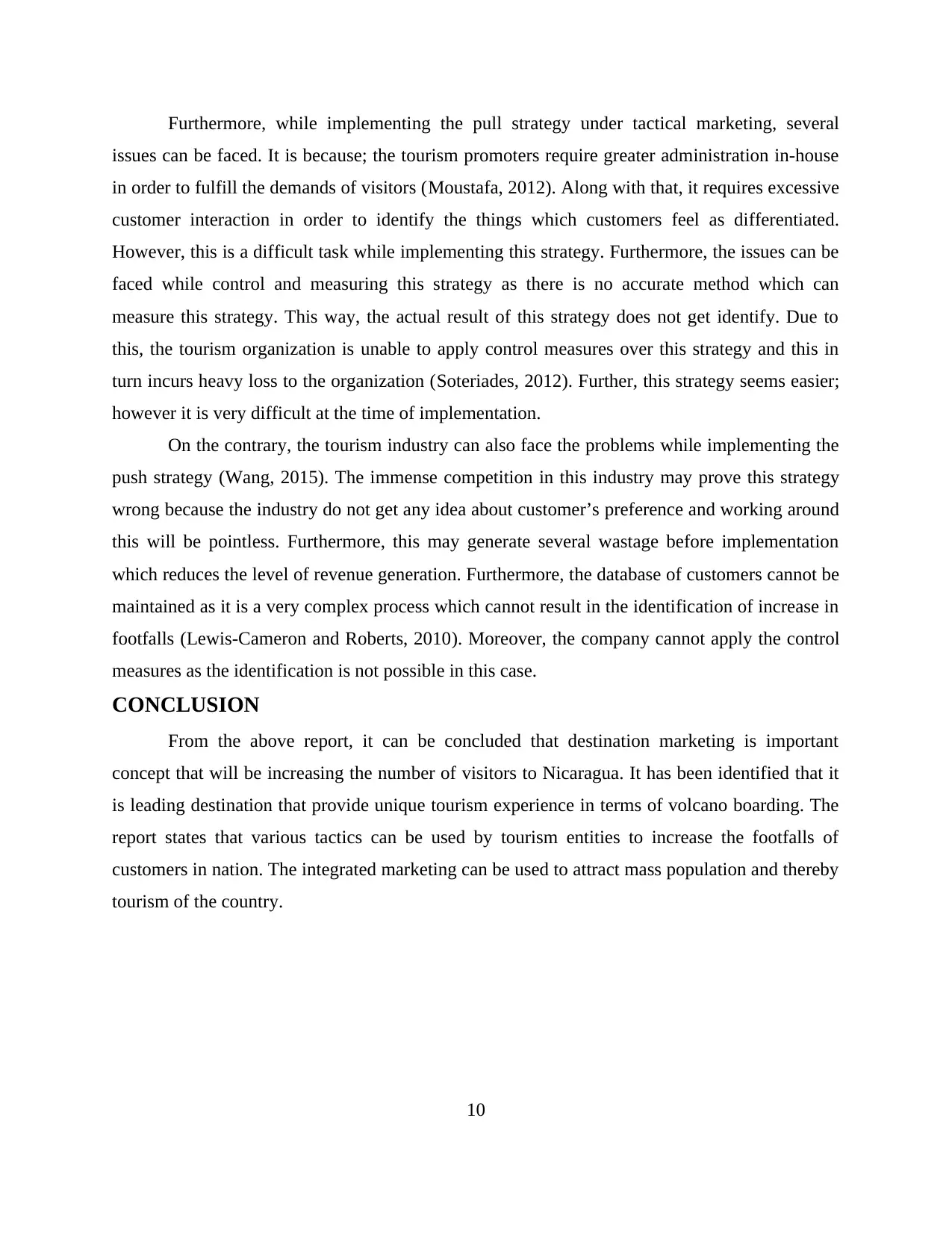
Furthermore, while implementing the pull strategy under tactical marketing, several
issues can be faced. It is because; the tourism promoters require greater administration in-house
in order to fulfill the demands of visitors (Moustafa, 2012). Along with that, it requires excessive
customer interaction in order to identify the things which customers feel as differentiated.
However, this is a difficult task while implementing this strategy. Furthermore, the issues can be
faced while control and measuring this strategy as there is no accurate method which can
measure this strategy. This way, the actual result of this strategy does not get identify. Due to
this, the tourism organization is unable to apply control measures over this strategy and this in
turn incurs heavy loss to the organization (Soteriades, 2012). Further, this strategy seems easier;
however it is very difficult at the time of implementation.
On the contrary, the tourism industry can also face the problems while implementing the
push strategy (Wang, 2015). The immense competition in this industry may prove this strategy
wrong because the industry do not get any idea about customer’s preference and working around
this will be pointless. Furthermore, this may generate several wastage before implementation
which reduces the level of revenue generation. Furthermore, the database of customers cannot be
maintained as it is a very complex process which cannot result in the identification of increase in
footfalls (Lewis-Cameron and Roberts, 2010). Moreover, the company cannot apply the control
measures as the identification is not possible in this case.
CONCLUSION
From the above report, it can be concluded that destination marketing is important
concept that will be increasing the number of visitors to Nicaragua. It has been identified that it
is leading destination that provide unique tourism experience in terms of volcano boarding. The
report states that various tactics can be used by tourism entities to increase the footfalls of
customers in nation. The integrated marketing can be used to attract mass population and thereby
tourism of the country.
10
issues can be faced. It is because; the tourism promoters require greater administration in-house
in order to fulfill the demands of visitors (Moustafa, 2012). Along with that, it requires excessive
customer interaction in order to identify the things which customers feel as differentiated.
However, this is a difficult task while implementing this strategy. Furthermore, the issues can be
faced while control and measuring this strategy as there is no accurate method which can
measure this strategy. This way, the actual result of this strategy does not get identify. Due to
this, the tourism organization is unable to apply control measures over this strategy and this in
turn incurs heavy loss to the organization (Soteriades, 2012). Further, this strategy seems easier;
however it is very difficult at the time of implementation.
On the contrary, the tourism industry can also face the problems while implementing the
push strategy (Wang, 2015). The immense competition in this industry may prove this strategy
wrong because the industry do not get any idea about customer’s preference and working around
this will be pointless. Furthermore, this may generate several wastage before implementation
which reduces the level of revenue generation. Furthermore, the database of customers cannot be
maintained as it is a very complex process which cannot result in the identification of increase in
footfalls (Lewis-Cameron and Roberts, 2010). Moreover, the company cannot apply the control
measures as the identification is not possible in this case.
CONCLUSION
From the above report, it can be concluded that destination marketing is important
concept that will be increasing the number of visitors to Nicaragua. It has been identified that it
is leading destination that provide unique tourism experience in terms of volcano boarding. The
report states that various tactics can be used by tourism entities to increase the footfalls of
customers in nation. The integrated marketing can be used to attract mass population and thereby
tourism of the country.
10
Paraphrase This Document
Need a fresh take? Get an instant paraphrase of this document with our AI Paraphraser
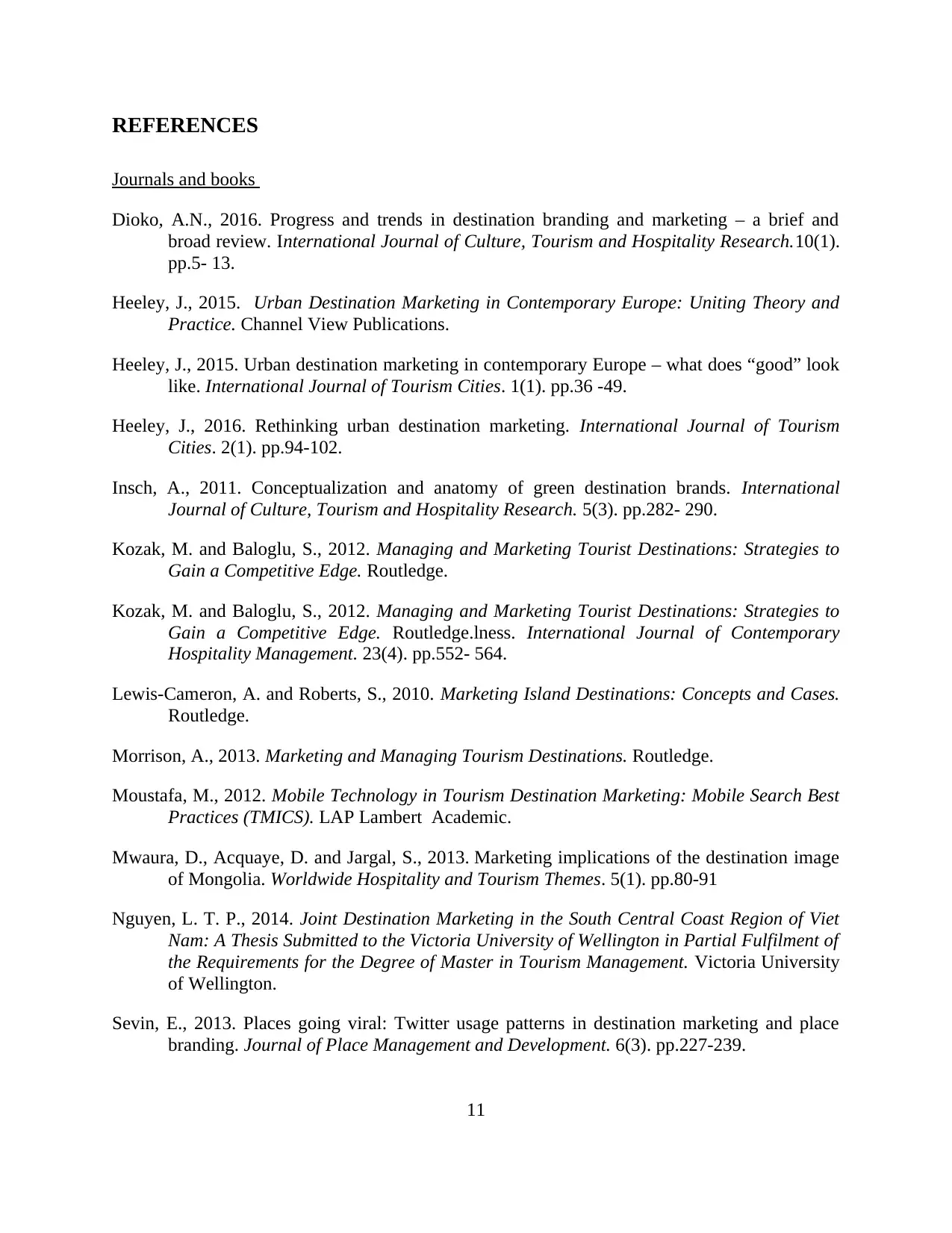
REFERENCES
Journals and books
Dioko, A.N., 2016. Progress and trends in destination branding and marketing – a brief and
broad review. International Journal of Culture, Tourism and Hospitality Research.10(1).
pp.5- 13.
Heeley, J., 2015. Urban Destination Marketing in Contemporary Europe: Uniting Theory and
Practice. Channel View Publications.
Heeley, J., 2015. Urban destination marketing in contemporary Europe – what does “good” look
like. International Journal of Tourism Cities. 1(1). pp.36 -49.
Heeley, J., 2016. Rethinking urban destination marketing. International Journal of Tourism
Cities. 2(1). pp.94-102.
Insch, A., 2011. Conceptualization and anatomy of green destination brands. International
Journal of Culture, Tourism and Hospitality Research. 5(3). pp.282- 290.
Kozak, M. and Baloglu, S., 2012. Managing and Marketing Tourist Destinations: Strategies to
Gain a Competitive Edge. Routledge.
Kozak, M. and Baloglu, S., 2012. Managing and Marketing Tourist Destinations: Strategies to
Gain a Competitive Edge. Routledge.lness. International Journal of Contemporary
Hospitality Management. 23(4). pp.552- 564.
Lewis-Cameron, A. and Roberts, S., 2010. Marketing Island Destinations: Concepts and Cases.
Routledge.
Morrison, A., 2013. Marketing and Managing Tourism Destinations. Routledge.
Moustafa, M., 2012. Mobile Technology in Tourism Destination Marketing: Mobile Search Best
Practices (TMICS). LAP Lambert Academic.
Mwaura, D., Acquaye, D. and Jargal, S., 2013. Marketing implications of the destination image
of Mongolia. Worldwide Hospitality and Tourism Themes. 5(1). pp.80-91
Nguyen, L. T. P., 2014. Joint Destination Marketing in the South Central Coast Region of Viet
Nam: A Thesis Submitted to the Victoria University of Wellington in Partial Fulfilment of
the Requirements for the Degree of Master in Tourism Management. Victoria University
of Wellington.
Sevin, E., 2013. Places going viral: Twitter usage patterns in destination marketing and place
branding. Journal of Place Management and Development. 6(3). pp.227-239.
11
Journals and books
Dioko, A.N., 2016. Progress and trends in destination branding and marketing – a brief and
broad review. International Journal of Culture, Tourism and Hospitality Research.10(1).
pp.5- 13.
Heeley, J., 2015. Urban Destination Marketing in Contemporary Europe: Uniting Theory and
Practice. Channel View Publications.
Heeley, J., 2015. Urban destination marketing in contemporary Europe – what does “good” look
like. International Journal of Tourism Cities. 1(1). pp.36 -49.
Heeley, J., 2016. Rethinking urban destination marketing. International Journal of Tourism
Cities. 2(1). pp.94-102.
Insch, A., 2011. Conceptualization and anatomy of green destination brands. International
Journal of Culture, Tourism and Hospitality Research. 5(3). pp.282- 290.
Kozak, M. and Baloglu, S., 2012. Managing and Marketing Tourist Destinations: Strategies to
Gain a Competitive Edge. Routledge.
Kozak, M. and Baloglu, S., 2012. Managing and Marketing Tourist Destinations: Strategies to
Gain a Competitive Edge. Routledge.lness. International Journal of Contemporary
Hospitality Management. 23(4). pp.552- 564.
Lewis-Cameron, A. and Roberts, S., 2010. Marketing Island Destinations: Concepts and Cases.
Routledge.
Morrison, A., 2013. Marketing and Managing Tourism Destinations. Routledge.
Moustafa, M., 2012. Mobile Technology in Tourism Destination Marketing: Mobile Search Best
Practices (TMICS). LAP Lambert Academic.
Mwaura, D., Acquaye, D. and Jargal, S., 2013. Marketing implications of the destination image
of Mongolia. Worldwide Hospitality and Tourism Themes. 5(1). pp.80-91
Nguyen, L. T. P., 2014. Joint Destination Marketing in the South Central Coast Region of Viet
Nam: A Thesis Submitted to the Victoria University of Wellington in Partial Fulfilment of
the Requirements for the Degree of Master in Tourism Management. Victoria University
of Wellington.
Sevin, E., 2013. Places going viral: Twitter usage patterns in destination marketing and place
branding. Journal of Place Management and Development. 6(3). pp.227-239.
11
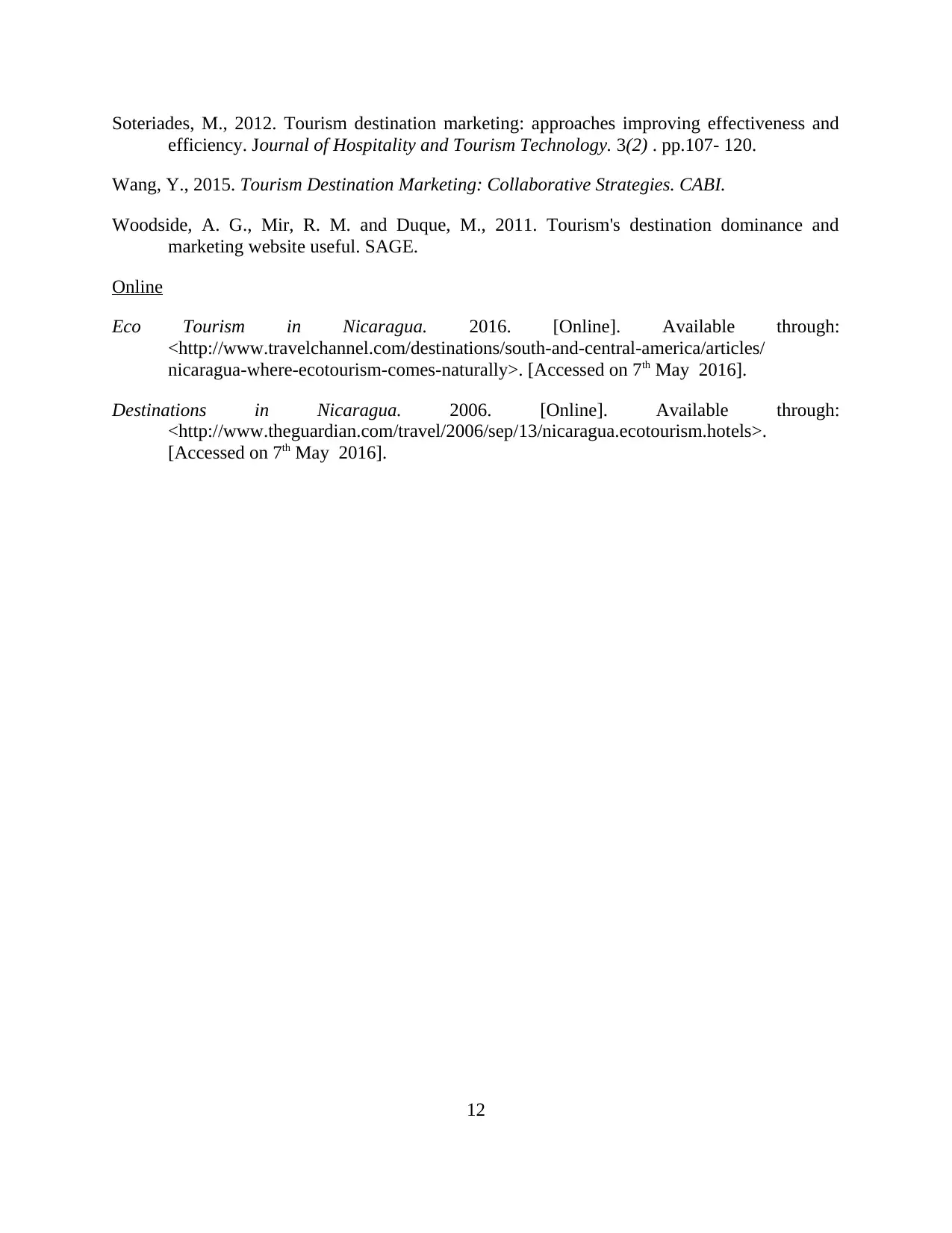
Soteriades, M., 2012. Tourism destination marketing: approaches improving effectiveness and
efficiency. Journal of Hospitality and Tourism Technology. 3(2) . pp.107- 120.
Wang, Y., 2015. Tourism Destination Marketing: Collaborative Strategies. CABI.
Woodside, A. G., Mir, R. M. and Duque, M., 2011. Tourism's destination dominance and
marketing website useful. SAGE.
Online
Eco Tourism in Nicaragua. 2016. [Online]. Available through:
<http://www.travelchannel.com/destinations/south-and-central-america/articles/
nicaragua-where-ecotourism-comes-naturally>. [Accessed on 7th May 2016].
Destinations in Nicaragua. 2006. [Online]. Available through:
<http://www.theguardian.com/travel/2006/sep/13/nicaragua.ecotourism.hotels>.
[Accessed on 7th May 2016].
12
efficiency. Journal of Hospitality and Tourism Technology. 3(2) . pp.107- 120.
Wang, Y., 2015. Tourism Destination Marketing: Collaborative Strategies. CABI.
Woodside, A. G., Mir, R. M. and Duque, M., 2011. Tourism's destination dominance and
marketing website useful. SAGE.
Online
Eco Tourism in Nicaragua. 2016. [Online]. Available through:
<http://www.travelchannel.com/destinations/south-and-central-america/articles/
nicaragua-where-ecotourism-comes-naturally>. [Accessed on 7th May 2016].
Destinations in Nicaragua. 2006. [Online]. Available through:
<http://www.theguardian.com/travel/2006/sep/13/nicaragua.ecotourism.hotels>.
[Accessed on 7th May 2016].
12
⊘ This is a preview!⊘
Do you want full access?
Subscribe today to unlock all pages.

Trusted by 1+ million students worldwide
1 out of 12